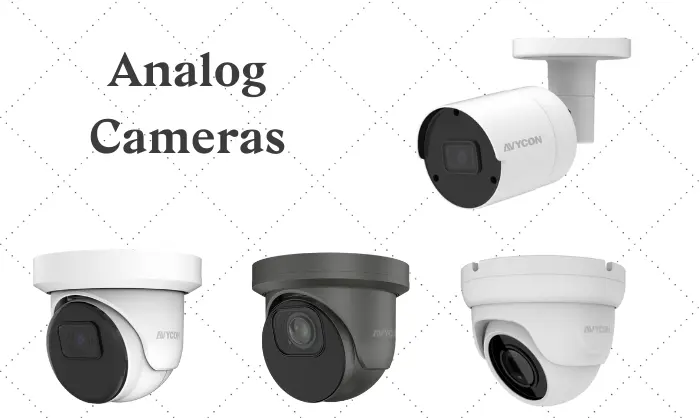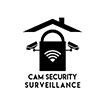Analog cameras are the traditional cameras used in CCTV systems. These cameras have long been a cornerstone of security and surveillance systems, providing a reliable and cost-effective solution for many businesses and homeowners. These cameras capture video and transmit it to a recording device through a coaxial cable.
Unlike modern IP (Internet Protocol) cameras, which use digital signals, analog cameras rely on analog signals for recording and transmitting video. Despite the increasing popularity of digital systems, analog cameras still hold their ground due to their affordability and simplicity.

How Do Analog Cameras Work?
Analog cameras work by capturing video footage using a CCD (Charge-Coupled Device) or CMOS (Complementary Metal-Oxide Semiconductor) sensor. The video signal is then converted into an analog signal and transmitted via coaxial cables to a recording device, typically a Digital Video Recorder (DVR). The DVR stores the video footage, allowing users to access, view, and review the recordings.
The simplicity of this system makes analog cameras easy to use. They don’t require complex network configurations, and for many users, this “plug and play” simplicity is a major advantage.
Types of Analog Cameras
Analog cameras come in various types, each serving different surveillance needs. The most common include bullet cameras, dome cameras, PTZ cameras, and C-mount cameras. These options provide versatility in security setups, offering varying features for both indoor and outdoor monitoring environments.
Bullet Cameras: Bullet cameras have a cylindrical shape and are commonly used outdoors for long-distance viewing due to their ability to focus on specific areas.
Dome Cameras: Dome cameras are known for their dome-shaped design, these cameras are typically used indoors, providing a wide-angle view while being discreet and vandal-resistant.
PTZ Cameras: PTZ (Pan-Tilt-Zoom cameras) can be remotely controlled to pan, tilt, and zoom, making them ideal for monitoring larger areas and offering flexible coverage.
C-mount Cameras: These cameras allow for interchangeable lenses, making them perfect for specialized applications where different focal lengths or zoom ranges are required.
Advantages of Analog Cameras
Cost-Effective:
One of the most significant benefits of analog cameras is their affordability. Analog systems are generally much cheaper than IP-based systems, especially when multiple cameras are required. This makes them an ideal choice for small businesses and homeowners on a budget.
Familiarity and Availability:
Analog cameras have been around for a long time, which means they are widely available and well-understood by many installers and users. Finding vendors, replacement parts, or installers is relatively easy, making them a practical choice for many.
Long-Distance Transmission:
Analog cameras can transmit video over long distances using coaxial cables. With twisted-pair cables, video can be transmitted up to 1.5 kilometers, while coax cables can cover up to 300 meters. This makes analog systems viable for large-scale installations.
Ease of Use:
Analog cameras are simple to operate, requiring no advanced technical knowledge. They are straightforward to install, and the accompanying DVR systems are typically user-friendly.
Compatibility with Existing Infrastructure:
If you already have an existing analog surveillance system, upgrading or adding more cameras can be done without major overhauls. You can simply add more cameras to the DVR.
Disadvantages of Analog Cameras
While analog cameras offer many benefits, there are also several limitations to consider:
Lower Video Quality:
Although high-definition (HD) analog cameras are available, their video quality is still generally lower than that of IP cameras. If you need crystal-clear images, particularly in situations where identifying fine details like license plates or faces is critical, analog cameras might not be the best choice.
Complex Cabling:
Analog systems require separate cables for power, video transmission, and data storage. This means installation can become cumbersome, especially in complex setups where multiple cameras are needed. Additionally, if the wiring is old or damaged, it may need to be replaced.
No Wireless Connectivity:
Analog cameras do not offer wireless options, unlike many modern IP cameras, which can transmit data over Wi-Fi. This limits flexibility in placement and can lead to additional installation costs.
Less Advanced Features:
IP cameras often come equipped with advanced features such as motion detection, two-way audio, and remote access via mobile apps. Analog cameras, on the other hand, are generally more basic, lacking many of these features.
Choosing Between Analog and IP Cameras
Analog cameras are widely used and have a straightforward operation compared to IP cameras. On the other hand, IP cameras use Internet Protocol, which controls data transmission between devices. These cameras often come with multiple advanced features.
When deciding the best option for your organization, IP cameras may seem like the ideal choice due to their digital nature. Many experts believe they represent the future of security systems, but your decision should depend on the size of your organization and its specific security requirements.
Best Applications for IP and Analog Cameras
The effectiveness of your security camera system depends on the context of its use. For larger organizations requiring over 32 cameras, IP cameras are a better option. They offer advantages in installation, cabling, storage, and video management, often proving more cost-effective. IP cameras are ideal for environments that need to perform multiple security tasks, such as monitoring, remote viewing, and advanced operational features.
Common Applications for IP cameras include:
- Large enterprises
- Office Buildings
- Education institutions
- Transportation hubs
- Government facilities
- Shopping Malls & Retail Stores
- Hospitals
- Distributor companies
- City-wide surveillance systems
For smaller businesses, particularly single-location stores, analog cameras may be a more practical choice. A DVR system may be sufficient for their needs, and analog cameras are easier to install and uninstall. Interestingly, casinos often use analog cameras due to their need for real-time control and zero delay in video display, making them ideal for such high-security environments.
Storage and Access to Video Footage
In an analog system, video footage is stored on a DVR, which captures and records the analog video signals. DVRs are usually equipped with hard drives that store hours, days, or even weeks of footage, depending on the capacity.
Access to recorded footage typically requires a physical connection to the DVR, either via a monitor or a connected device within the same network. Unlike modern IP systems that offer cloud storage and remote access, analog systems are generally limited to on-site access unless they are specifically upgraded with external devices.
Analog Camera Installation
The installation of analog cameras typically involves using coaxial cables, such as RG59 or RG6. These cables are responsible for transmitting video signals from the camera to the DVR. The type of cable used can affect both video quality and transmission distance:
- RG59 Cables: These are thinner and easier to handle during installation but have a shorter transmission range.
- RG6 Cables: These thicker cables allow for longer transmission distances without signal degradation, but they can be more challenging to install, especially in tight spaces or when corners need to be rounded.
Alternatively, analog CCTV systems can use CAT5 cables with video balun converters. A video balun converts the analog signal into a balanced one, allowing it to be transmitted via CAT5 cables, which are typically used in IP camera installations.
Night Vision in Analog Cameras
Analog cameras with night vision use infrared technology to capture clear images in darkness. While their IR capabilities may not be as advanced as modern IP cameras, they still provide effective day-and-night surveillance at a lower cost.
Analog vs. IP Cameras: Which Is Better?
Choosing between analog and IP cameras depends on various factors, including budget, required video quality, and the complexity of your security needs.
Cost:
Analog systems are generally cheaper to set up, especially if you’re working with multiple cameras. However, IP cameras are often more cost-effective in the long run due to lower cabling requirements and advanced features.
Video Quality:
IP cameras offer superior video quality, with resolutions often reaching up to 12MP or higher. In contrast, most analog cameras max out at 2MP, although some HD analog models offer up to 8MP resolution.
Advanced Features:
IP cameras come with advanced features like motion detection, remote access, and two-way audio, making them more suitable for modern, high-tech surveillance systems. Analog cameras, while reliable, lack many of these functionalities.
Installation:
Analog systems require more cabling and generally take longer to install, but they are easier to operate once set up. IP systems, while more complex to configure, require less physical cabling.
Final Thoughts
Analog cameras remain a viable option for many, particularly those looking for a cost-effective, easy-to-use security solution. Their long-standing presence in the market means they are familiar, reliable, and widely available. While they may lack some of the advanced features and high-resolution capabilities of IP cameras, analog systems can still provide excellent value, especially for smaller businesses and residential use.
When deciding whether to go with analog or IP cameras, it’s essential to assess your specific needs, budget, and infrastructure. Analog systems may be the perfect fit for basic surveillance setups, while IP systems are ideal for more advanced and scalable operations.
If you’re looking for security camera installation services in Indiana and nearby areas for your business or home, contact CAM Security Surveillance. We offer cost-effective security solutions for all types of businesses and homes. Contact us today for a free quote!








